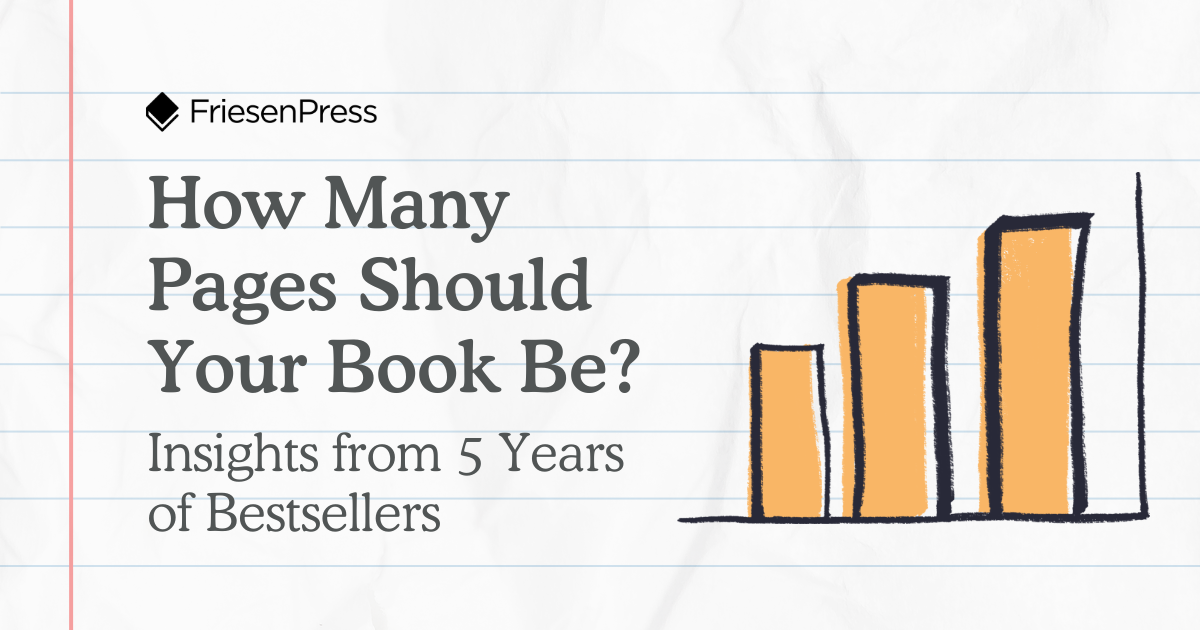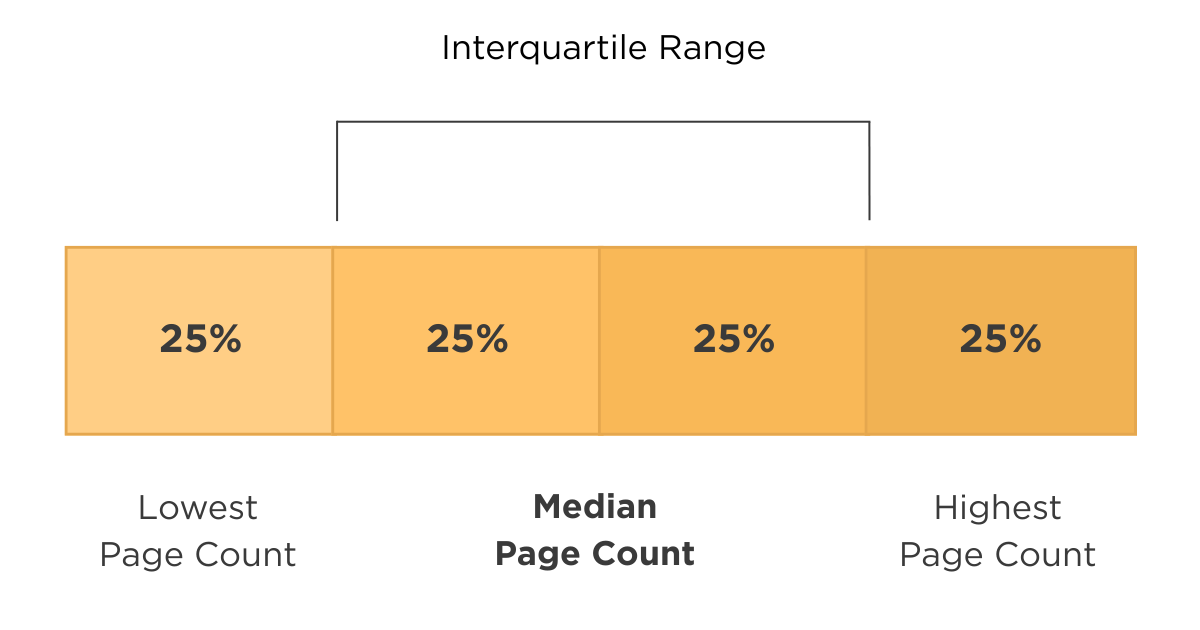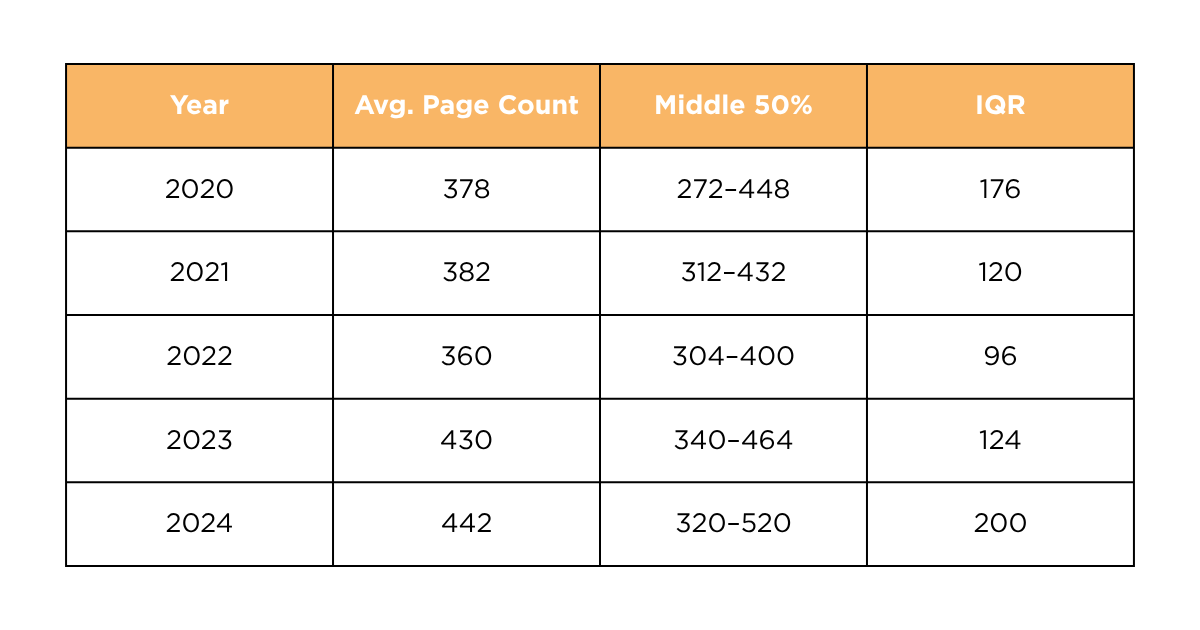How Many Pages Should Your Book Be? Insights from 5 Years of Bestsellers
/It’s common for authors to get caught up in branding and cover design — you only get one chance to make a first impression, after all — but there’s another major factor that impacts how your book is perceived at online and physical points of purchase:
Page count.
Understanding the page count norms in your given genre can help your book fit in or stand out relative to reader expectations. These norms can shape how potential buyers perceive your book’s value — and even your level of professionalism — before they’ve read a single word. (The good news is this is something you and your publishing team can work to manage in the editing and design process.)
While there isn’t a one-size-fits-all magic number of pages that will guarantee your book to be a bestseller, patterns exist for a reason. If we could get data-driven insights into bestselling books that revealed these patterns, what might we learn?
Well, you’re reading the right article, because that’s precisely what we’ve set out to do.
What we found might not give you a magic number, but it does point to some valuable, category and genre-specific patterns worth considering during the publishing process.
Key Takeaways for Authors
After sifting through and analyzing 5 years’ worth of Amazon’s top 50 bestsellers, what should you keep in mind in order to optimize the length of your next book?
Fiction Demands More Room: Be prepared for your novel to be longer than a typical nonfiction book. While serving the story, give your characters and plot the space they need to breathe and develop authentically.
Nonfiction Values Concision: For nonfiction, impact often comes from clarity and efficiency. Don’t add words just to hit a prescribed page count. Every line, paragraph, and page should earn its keep.
Genres Uphold Expectations: More than any other factor, your genre will dictate reader expectations for length. A 600-page fantasy might need that length to feel well developed, while a 200-page thriller might find that's the limit to perfectly sustain suspense. Understand the expectations of your chosen genre.
Focus on the Content First: While these insights are valuable, they are guidelines, not commandments. Never force your story or message to fit an arbitrary page count. If your narrative demands a certain length to be fully realized, trust that. A well-told story that runs a little short will always outperform a padded story that exceeds genre norms.
Methodology
To create this report, our team leveraged the indexing power of ChatGPT to help us extract and organize half a decade of bestseller charts from Amazon.com. We manually validated and analyzed the top 50 bestsellers from each of the past five years, pulled their page counts and trim sizes, and sorted them by category and genre.
To avoid skewing the results, we excluded book types with non-standard sizes and formatting, such as cookbooks, graphic novels, and children’s picture books. All page counts are based on the bestselling edition listed (i.e., the hardcover of a book may be in the top 50, but the paperback is not).
While this data has a high level of accuracy in determining book length via page count, it’s important to note that a page in one book is not necessarily equal to a page in another. This is due in part to trim size. For instance, hardcovers have larger dimensions than softcovers, which will affect the interpretation of length. Word count is more precise, but the availability and reliability of bestseller data on this is limited.
Overall Trends in Bestseller Lengths
So, what’s the average length of an Amazon bestseller? The data shows that across all categories and genres over the last five years, the typical bestseller clocks in at 398 pages.
However, the average only tells part of the story. We broke down our page count data further with the help of a term you might recall from statistics class, called interquartile range (IQR).
While it sounds a bit technical, IQR simply means focusing our analysis on the middle 50% of book lengths in a given category or genre. The page counts spanning that 50% range — the interquartile range — helps us more accurately understand where most books cluster by separating them from the outliers on the low and high ends:
The Amazon data shows that overall 50% of bestsellers fall within the 320–450 page range. This means that 25% of titles are shorter, impactful reads like a 300-page self-help book or novella, and 25% are more in-depth, immersive experiences like an 800+ page Brandon Sanderson fantasy epic.
These observations suggest there’s no single “correct” answer overall, but rather a dynamic sweet spot influenced by the various factors we’re about to explore.
Our year-over-year analysis of the top 50 bestsellers expands on these insights with more detail. For reasons we will uncover below, the average page count increased from 378 to 442 between 2020 and 2024, and with it the Middle 50% per year saw the range widen by +24 pages after some fluctuations. From this we can infer a greater appetite or acceptance of longer titles from readers:
average page count metrics of amazon bestsellers, 2020-2024
The overall average bestseller page count of 398 sits slightly in the upper part of the interquartile range of 320–450, so fewer titles are in the lower range, like the 300s.
Fiction vs. Nonfiction
As you might expect, page counts diverge significantly when we separate into the realms of storytelling and information. To continue the previous table, we’ve included a breakdown of fiction and nonfiction book statistics to explore these different categories:
average page count metrics of amazon bestsellers in fiction and nonfiction categories, 2020-2024
Fiction
For fiction writers, it’s not just about telling a story, but telling it at the right pace. And our data reveals what that pace often looks like for bestsellers. On average, fiction bestsellers tended to be longer, averaging around 425 pages. Fiction often requires more space for character development, intricate plot lines, worldbuilding, and pacing that allows readers to truly immerse themselves in the narrative.
The 425 page count average is above the top number of the middle 50% range (336–424), which indicates a right-skewed distribution — meaning there is a large amount of very long books to pull the average up.
Nonfiction
In contrast, nonfiction bestsellers often prove that when it comes to knowledge, sometimes less is more. Our analysis found that nonfiction bestsellers were notably shorter on average, coming in at approximately 365 pages. This difference highlights bestselling nonfiction’s tendency to convey information, insights, or actionable advice efficiently. While there are still some genres that demand comprehensive treatment (like biographies and history books), many successful nonfiction books prioritize clarity and conciseness, delivering their message without unnecessary filler.
The 365 page count average is only just above the median, which indicates a symmetrical distribution. This means that despite the overall variability in nonfiction book lengths demonstrated in a wide IQR of 276–443 (167 pages), there is a strong central cluster of books around the 365-page mark.
While the average page count difference between fiction and nonfiction is about 60 pages, the trim size choices between book types will somewhat narrow that gap:
Fiction books are generally in more consistent sizes (like 5" × 8" or 5.5" × 8.5") to fit comfortably in your hand and optimize the reading experience. The smaller size and therefore thicker appearance could potentially be a strategic choice to suggest depth or value.
Typical Range: 5.25" × 8"– 5.5" × 8.5" (paperback), 6.2" × 9.2"– 6.5" × 9.6" (hardcover)
Nonfiction books show more variability in trim size, likely due to layout choices (charts, photos, footnotes, etc.) and the function of those books (memoirs, finance, textbooks, etc.). Despite this, the typical nonfiction book’s trim size is more on the larger side compared to fiction books. Part of the reason for this is because the number of bestselling hardcover editions is much fewer among fiction (36%), whereas in nonfiction it’s generally more even (57%).
Typical Range: 5.0" × 8"–5.5" × 8.5" (paperback), 6" × 9"–6.5" × 9.6" (hardcover)
Length by Genre
Let’s go another level deeper by looking into the genre trends within fiction and nonfiction. Here, the nuances of book length become more apparent as each genre often carries certain audience expectations about its scope and pacing. Bestsellers tend to align with these norms as it is often a factor in their success.
Here’s a look at the top three genres and the insightful lessons learned from the Amazon.com bestseller lists:
1. Romance had the highest number of titles in the top 50 bestseller list over the last 5 years at a proportion of 20%. In 2020 and 2021, this genre (and its subgenres) were only a small fraction at 1 and 3 titles respectively, but by 2022 there was an explosion of success up to 17 titles. These were mostly contemporary romances (13), but each year after, that subgenre dwindled and fantasy romance (or “romantasy”) started to take its place at the highest levels. In 2024, romantasy was itself 16% of the list and its rival only 6% (with romance holding 26% overall).
We say all this to give one potential explanation for the page count increase in fiction over this five-year period. Contemporary romances are often standalone, character-driven love stories, but romantasy takes things further with an expansive, longer form fantasy world that is developed and often explored throughout a series of books — and that requires higher word counts to achieve. While contemporary and young adult romances are approximately 320 pages with a narrow middle range hovering at most around 400 pages, the romance-fantasy hybrid has an average page count of 544 pages (146 more than the average bestseller) and middle range heights of 656!
2. Self-Help and Personal Development (14%) are typically on the shorter side, averaging just 296 pages with a middle range of 224–373. This makes sense as they are often designed for quick consumption for simple, actionable advice. Readers want practical insights they can easily understand and that get to the point quickly.
As a consequence, writers in this genre should refine their ideas, remove the fluff, and make sure each chapter specifically drives value. Staying within the 224–373 pages keeps your book approachable and marketable.
3. Memoir (11%) length can range depending on the subject’s life and the depth of research, but often fall between 252–384 pages at an average of 339 pages. This is long enough to immerse the reader, but short enough to keep the story focused on a compelling period of your life.
Memoir readers want a meaningful, reflective narrative that feels worth the journey, but not so sprawling that it feels indulgent and meandering. The few outliers with massive page counts (up as high as the 700 mark) seem to be reserved for high-profile memoirs like Barack Obama’s A Promised Land.
Understanding bestseller length isn’t about conforming to a formula or statistics, but about strategic awareness. In the end, readers are most concerned about whether your book delivers than whether it falls into some page count sweet spot. Use these trends only as informed reference points.
In analyzing the makeup of the books selling at the highest levels, we nonetheless hope these data-driven insights can help you refine your craft, make savvy publishing choices, and improve your ability to connect with your target audience!














